Time to Transition to Agroecology in Africa
As COVID-19 threatens farming communities across Africa already struggling with climate change, the continent is at a crossroads. Will its people and their governments continue trying to replicate industrial farming models promoted by developed countries? Or will they move boldly into the uncertain future, embracing ecological agriculture?
It is time to choose. Africa is projected to overtake South Asia by 2030 as the region with the greatest number of hungry people. An alarming 264 million people in Africa now suffer from “undernourishment,” the U.N. term for chronic hunger. If policies do not change, experts project that number to soar to 433 million in 2030.
The evidence is now convincing that the Green Revolution for Africa, with its heavily funded promotion of commercial seeds and synthetic fertilizers, has failed to bring progress for Africa’s farmers. Productivity has improved marginally, and only for a few chosen crops such as maize. Others have withered in a drought of neglect from donor agencies and government leaders. Small-scale farming households, the intended beneficiaries of Green Revolution programs, seem scarcely better off. Poverty remains high, and severe food insecurity has increased nearly 50% in Sub-Saharan Africa since 2006.

